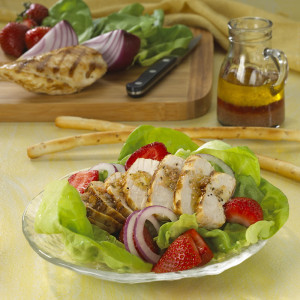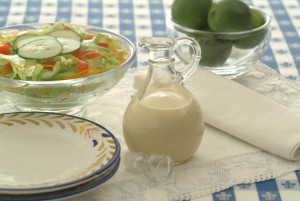Lettuce Help You Toss a Kidney-Friendly Salad
With New Year’s resolutions in full gear, choosing more nutrient-dense meals may be at the forefront of your mind. A great way to get a big nutrient punch into a lighter meal is by adding salads into your meal plan. Salads offer many health benefits, including lots of vitamins and minerals, fiber, and lean protein. However, for someone trying to follow a kidney-friendly diet, this can seem daunting. Frequent questions include, “Which veggies have too much potassium?” and “My doctor said to avoid all green veggies!” as well as, “What about the calories and sodium in dressings?”
Fear not! DaVita is here to help guide you in a kidney-friendly direction.
First, let’s start with the base of the salad: lettuce. Your safest bets include iceberg, arugula, Bibb, Boston, red leaf or green leaf lettuces. If you are not on a blood thinning medication, raw spinach, romaine and kale are good options as well. Keep your lettuce portion to about 1 cup or ½ cup if choosing kale or raw spinach.
Second, add fruits and veggies that are low in potassium. A few good vegetable options include: cucumber, carrots, broccoli, celery and bell peppers. Some lower potassium fruits include canned pears or peaches, strawberries, pineapple chunks and chopped apples. Keep your total portion of low-potassium fruits and veggies to ½ cup.
 One of the most important parts of a kidney-friendly diet is getting the right amount and type of protein. Add 3 to 4 ounces of grilled chicken, turkey or shrimp to your salad for an extra 20-28 grams of protein. Steak, salmon, tuna or egg are also great options! If you are limiting protein, adjust the amount to match your meal plan.
One of the most important parts of a kidney-friendly diet is getting the right amount and type of protein. Add 3 to 4 ounces of grilled chicken, turkey or shrimp to your salad for an extra 20-28 grams of protein. Steak, salmon, tuna or egg are also great options! If you are limiting protein, adjust the amount to match your meal plan.
If you want to add starch to your salad, choose cooked rice, pasta or low-sodium croutons. Try to avoid adding cheese to your salad because of its high-phosphorus content. If you do add cheese, keep it to a 1-2 tablespoon or 1 ounce portion.
 Dressings can be loaded with calories, sodium and phosphorus. One of the safest options is oil and vinegar. For extra flavor, add Mrs. Dash herb seasoning. Check salad dressing labels for sodium content or easily make your own homemade salad dressing. Several recipes such as Basic Salad Dressing, Creamy Vinaigrette Dressing and Honey Mustard Dressing are available on DaVita.com/recipes.
Dressings can be loaded with calories, sodium and phosphorus. One of the safest options is oil and vinegar. For extra flavor, add Mrs. Dash herb seasoning. Check salad dressing labels for sodium content or easily make your own homemade salad dressing. Several recipes such as Basic Salad Dressing, Creamy Vinaigrette Dressing and Honey Mustard Dressing are available on DaVita.com/recipes.
By following these guidelines you will feel more comfortable including salads in your diet to help you reach your health goals!
Additional Kidney Diet Resources
Visit DaVita.com and explore these diet and nutrition resources:
DaVita Kidney-Friendly Recipes
This article is for informational purposes only and is not a substitute for medical advice or treatment. Consult your physician and dietitian regarding your specific diagnosis, treatment, diet and health questions.

Recent Comments